Remove the FireBird Remote Access Trojan (RAT) from the operating system
TrojanAlso Known As: FireBird remote access trojan
Get free scan and check if your device is infected.
Remove it nowTo use full-featured product, you have to purchase a license for Combo Cleaner. Seven days free trial available. Combo Cleaner is owned and operated by RCS LT, the parent company of PCRisk.com.
What kind of malware is the FireBird RAT?
FireBird is a Remote Access Tool (or alternatively, when used in a malicious capacity, it is termed a Remote Access Trojan) or 'RAT'.
On initial inspection, this may seem to be a legitimate piece of software, however, its list of capabilities/features (e.g. anti-detection, functionality without input or permission of the connected machine's user, etc.) clearly indicate that FireBird was developed with malicious use in mind.
Furthermore, this program is offered for purchase in a cryptocurrency, the transactions of which are difficult/impossible to trace due to the lack of personal information required. Therefore, cyber criminals wishing to purchase this dangerous software can remain anonymous.
FireBird allows remote access and control over an infected device. It can be used in various dangerous ways that endanger system integrity and user safety.
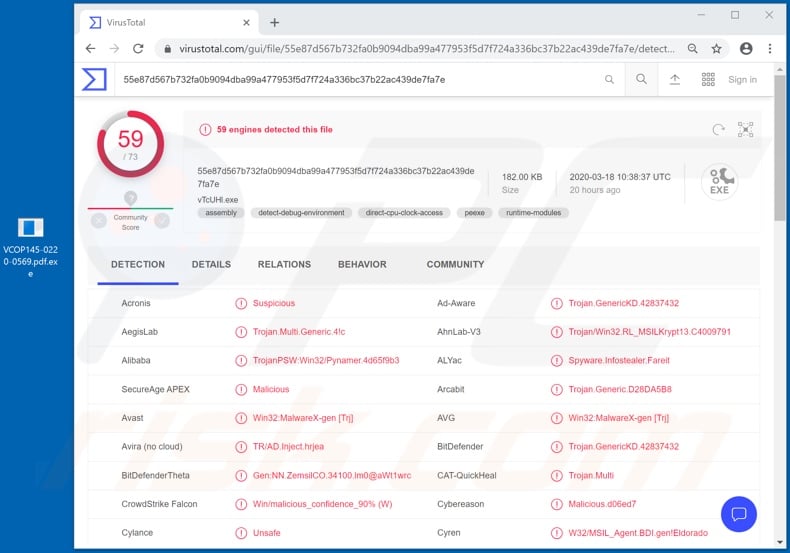
FireBird RAT overview
The FireBird RAT is highly functional malware with various capabilities. Some examples of its functions and potential misuse follow. FireBird can allow cyber criminals user-level control over a targeted machine.
This malicious software can manage Windows Registry (containing information, parameters, options and other values of software and hardware installed on the system). Therefore, it can give commands to install/uninstall applications and control connected hardware.
The latter can be used to turn the monitor on/off, enable/disable the mouse, open/close the CD player, record audio via the microphone, record via the webcam, play audio, etc. Any recorded material can be used for blackmail purposes. FireBird can interact with Task Manger and end any running processes, including that of Task Manager itself.
Coupled with its capability to infiltrate data and execute (i.e., run) programs, it can cause chain infections (i.e. download/install additional malware). FireBird can exfiltrate data stored in the system and browsers such as Google Chrome and Mozilla Firefox. It can also recover log-ins and passwords from these browsers and QQ messenger, FileZilla file transfer application, etc.
This RAT has keylogging capabilities (it can record key strokes). This capability is used to steal the credentials (i.e., log-ins and passwords) of various accounts such as emails, social networking, social media, e-commerce, financial/banking and so on.
Communication accounts can be misused by criminals to demand money from the genuine owner's contacts/friends and to further malicious software. E-commerce (online store) accounts often save credit card details. Thus, cyber criminals can use them to make online purchases.
FireBird can also mine certain cryptocurrencies. These are some examples of how this malware can operate and the misuse it can facilitate. To summarize, FireBird can cause additional system infections, lead to significant financial loss, serious privacy issues and identity theft.
If you suspect that FireBird (or another malicious program) has already infected the system, remove it using anti-virus software immediately.
| Name | FireBird remote access trojan |
| Threat Type | Trojan, password-stealing virus, banking malware, spyware. |
| Detection Names | Avast (Win32:MalwareX-gen [Trj]), BitDefender ( Trojan.GenericKD.42837432), ESET-NOD32 (A Variant Of MSIL/Kryptik.VAA), Kaspersky (HEUR:Trojan-PSW.MSIL.Agensla.gen), Full List (VirusTotal) |
| Malicious Process Name(s) | MSBuild.exe (process name may vary) |
| Symptoms | Trojans are designed to stealthily infiltrate the victim's computer and remain silent, and thus no particular symptoms are clearly visible on an infected machine. |
| Distribution methods | Infected email attachments, malicious online advertisements, social engineering, software 'cracks'. |
| Damage | Stolen passwords and banking information, identity theft, the victim's computer added to a botnet. |
| Malware Removal (Windows) |
To eliminate possible malware infections, scan your computer with legitimate antivirus software. Our security researchers recommend using Combo Cleaner. Download Combo CleanerTo use full-featured product, you have to purchase a license for Combo Cleaner. 7 days free trial available. Combo Cleaner is owned and operated by RCS LT, the parent company of PCRisk.com. |
More examples of RATs
NetWire, Koadic, BlackNix and PiXie are some examples of other remote access Trojans. While their functionalities may differ, they have just one purpose: to generate revenue for the cyber criminals using them. Regardless of how they work, they can cause serious problems. Therefore, it is paramount to remove all malware without delay to ensure device and user safety.
How did FireBird infiltrate my computer?
Since FireBird is available for purchase online, its proliferation methods can vary depending on the cyber criminals using it. Malware is usually spread via spam campaigns, backdoor Trojans, illegal activation tools ("cracks"), bogus updates and untrusted download channels.
Spam campaigns are used to send deceptive emails containing infectious files attached to (or linked inside) them. Infectious files come in variety of formats (e.g. PDF and Microsoft Office documents, archive and executable files, JavaScript, etc.). When these are executed, run or otherwise opened, the infection process is triggered.
Some Trojan-type malware is capable of downloading/installing additional malicious programs. Rather than activating licensed products, illegal activation ("cracking") tools can download/install malicious software. Fake updaters infect systems by abusing flaws of outdated products and/or simply installing malware rather than the promised updates.
Disguised malicious content if often downloaded unintentionally from untrusted sources (e.g. unofficial and free file-hosting websites, Peer-to-Peer sharing networks and other third party downloaders).
How to avoid installation of malware
You are advised against opening dubious or irrelevant emails, especially any attachments or links present in them, due to the risk of malware infections. Use only official and verified download channels. Activate and update products with functions/tools provided by legitimate developers.
Illegal activation tools ("cracks") and third party updaters are often used to proliferate malicious programs. It is crucial to have a reputable anti-virus/anti-spyware suite installed. Furthermore, keep this software up to date and run regular system scans for the removal detected/potential threats.
If you believe that your computer is already infected, we recommend running a scan with Combo Cleaner Antivirus for Windows to automatically eliminate infiltrated malware.
Screenshot of FireBird RAT process in Windows Task Manager ("MSBuild.exe" - the process name might vary):
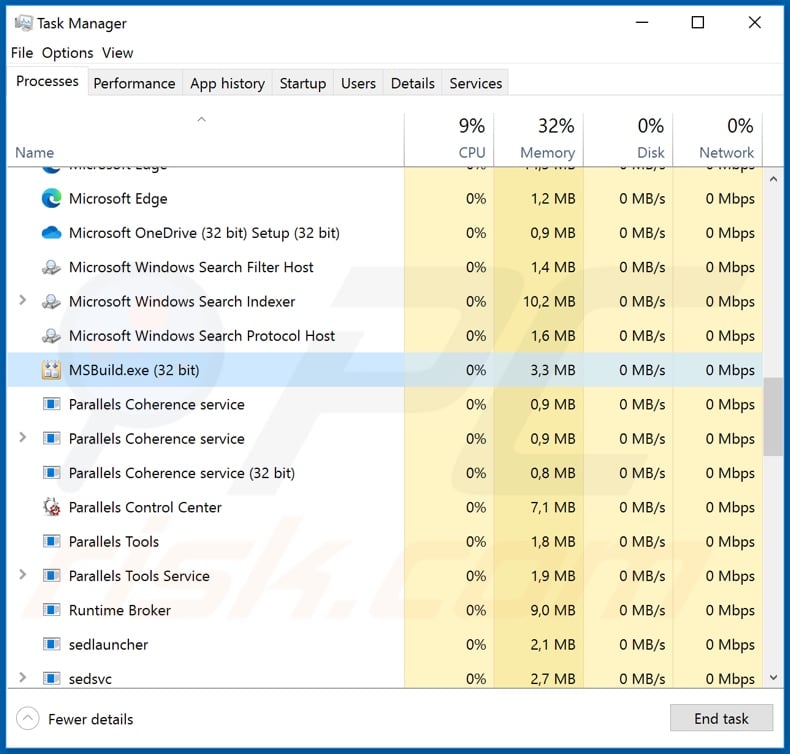
Appearance of the website used to promote FireBird RAT (GIF):
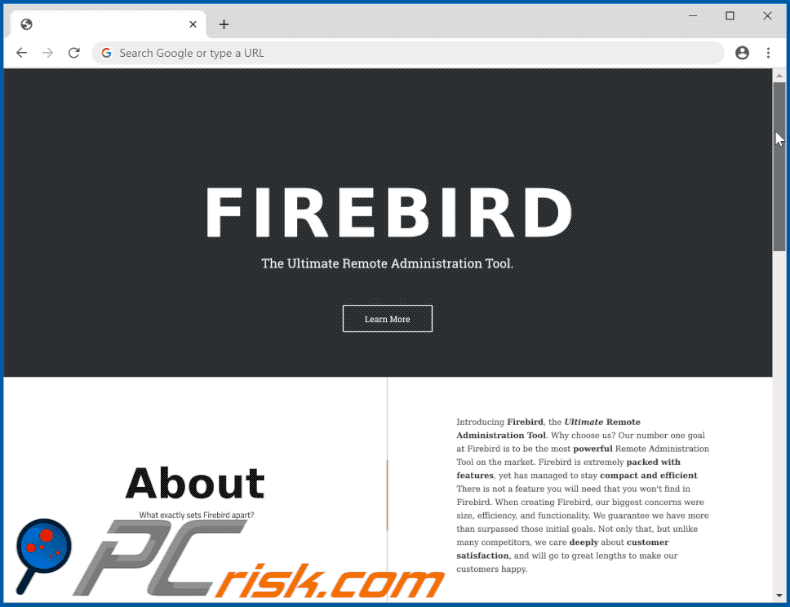
Screenshot of a fake World Health Organization (WHO) website (unfoundation[.]website) used to spread FireBird RAT:
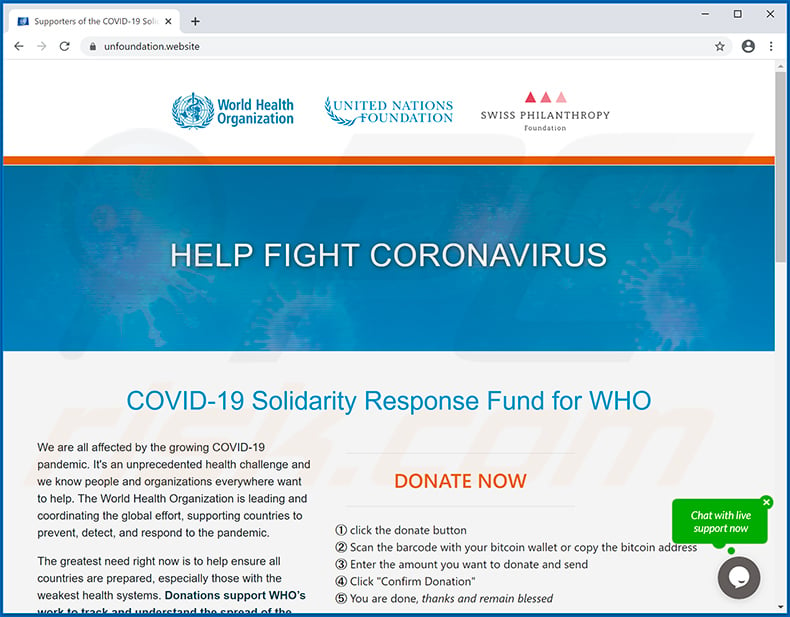
Screenshot of a malicious Microsoft Excel document ("DHL_Shipment_AWB5172133171.xls") used to spread FireBird RAT:
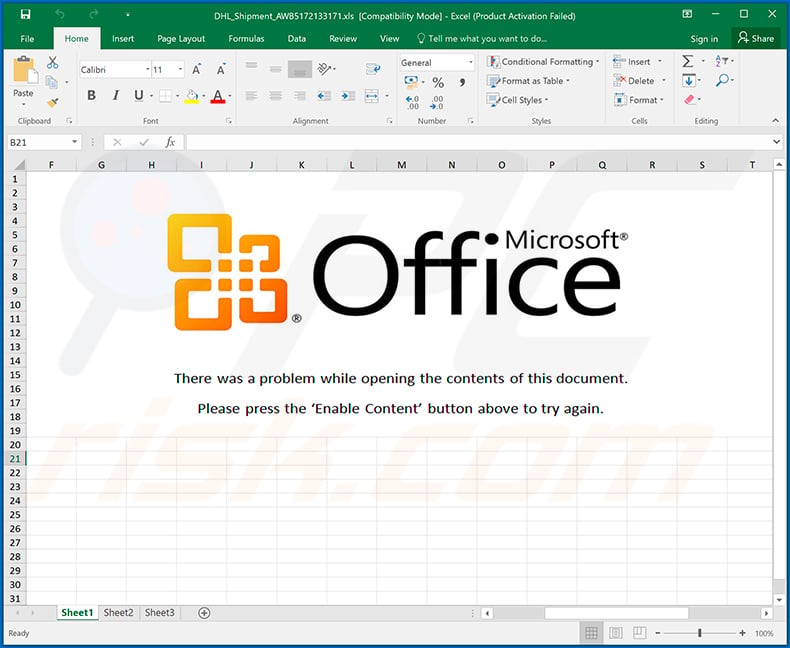
Instant automatic malware removal:
Manual threat removal might be a lengthy and complicated process that requires advanced IT skills. Combo Cleaner is a professional automatic malware removal tool that is recommended to get rid of malware. Download it by clicking the button below:
DOWNLOAD Combo CleanerBy downloading any software listed on this website you agree to our Privacy Policy and Terms of Use. To use full-featured product, you have to purchase a license for Combo Cleaner. 7 days free trial available. Combo Cleaner is owned and operated by RCS LT, the parent company of PCRisk.com.
Quick menu:
- What is FireBird?
- STEP 1. Manual removal of FireBird malware.
- STEP 2. Check if your computer is clean.
How to remove malware manually?
Manual malware removal is a complicated task - usually it is best to allow antivirus or anti-malware programs to do this automatically. To remove this malware we recommend using Combo Cleaner Antivirus for Windows.
If you wish to remove malware manually, the first step is to identify the name of the malware that you are trying to remove. Here is an example of a suspicious program running on a user's computer:

If you checked the list of programs running on your computer, for example, using task manager, and identified a program that looks suspicious, you should continue with these steps:
 Download a program called Autoruns. This program shows auto-start applications, Registry, and file system locations:
Download a program called Autoruns. This program shows auto-start applications, Registry, and file system locations:

 Restart your computer into Safe Mode:
Restart your computer into Safe Mode:
Windows XP and Windows 7 users: Start your computer in Safe Mode. Click Start, click Shut Down, click Restart, click OK. During your computer start process, press the F8 key on your keyboard multiple times until you see the Windows Advanced Option menu, and then select Safe Mode with Networking from the list.

Video showing how to start Windows 7 in "Safe Mode with Networking":
Windows 8 users: Start Windows 8 is Safe Mode with Networking - Go to Windows 8 Start Screen, type Advanced, in the search results select Settings. Click Advanced startup options, in the opened "General PC Settings" window, select Advanced startup.
Click the "Restart now" button. Your computer will now restart into the "Advanced Startup options menu". Click the "Troubleshoot" button, and then click the "Advanced options" button. In the advanced option screen, click "Startup settings".
Click the "Restart" button. Your PC will restart into the Startup Settings screen. Press F5 to boot in Safe Mode with Networking.

Video showing how to start Windows 8 in "Safe Mode with Networking":
Windows 10 users: Click the Windows logo and select the Power icon. In the opened menu click "Restart" while holding "Shift" button on your keyboard. In the "choose an option" window click on the "Troubleshoot", next select "Advanced options".
In the advanced options menu select "Startup Settings" and click on the "Restart" button. In the following window you should click the "F5" button on your keyboard. This will restart your operating system in safe mode with networking.

Video showing how to start Windows 10 in "Safe Mode with Networking":
 Extract the downloaded archive and run the Autoruns.exe file.
Extract the downloaded archive and run the Autoruns.exe file.

 In the Autoruns application, click "Options" at the top and uncheck "Hide Empty Locations" and "Hide Windows Entries" options. After this procedure, click the "Refresh" icon.
In the Autoruns application, click "Options" at the top and uncheck "Hide Empty Locations" and "Hide Windows Entries" options. After this procedure, click the "Refresh" icon.

 Check the list provided by the Autoruns application and locate the malware file that you want to eliminate.
Check the list provided by the Autoruns application and locate the malware file that you want to eliminate.
You should write down its full path and name. Note that some malware hides process names under legitimate Windows process names. At this stage, it is very important to avoid removing system files. After you locate the suspicious program you wish to remove, right click your mouse over its name and choose "Delete".

After removing the malware through the Autoruns application (this ensures that the malware will not run automatically on the next system startup), you should search for the malware name on your computer. Be sure to enable hidden files and folders before proceeding. If you find the filename of the malware, be sure to remove it.

Reboot your computer in normal mode. Following these steps should remove any malware from your computer. Note that manual threat removal requires advanced computer skills. If you do not have these skills, leave malware removal to antivirus and anti-malware programs.
These steps might not work with advanced malware infections. As always it is best to prevent infection than try to remove malware later. To keep your computer safe, install the latest operating system updates and use antivirus software. To be sure your computer is free of malware infections, we recommend scanning it with Combo Cleaner Antivirus for Windows.
Frequently Asked Questions (FAQ)
My computer is infected with FireBird RAT, should I format my storage device to get rid of it?
Formatting your storage device is one of the ways to ensure the malware is completely removed. However, before taking such drastic action, you should try removing it with trusted antivirus or anti-malware software.
What are the biggest issues that malware can cause?
The effects of malware depend on its type and capabilities. Common consequences include identity theft, financial loss, additional infections, data loss, and reduced device performance.
What is the purpose of FireBird RAT?
The FireBird RAT gives cybercriminals extensive control over infected systems. It allows them to manipulate the operating system, steal sensitive data, install additional malware, record keystrokes, and mine cryptocurrencies.
How did FireBird RAT infiltrate my computer?
Threat actors commonly deploy malware through outdated software, pirated programs, technical support scams, and phishing emails with malicious attachments or links. They also use P2P networks, compromised websites, fake software updates, infected USB drives, malicious ads, and similar channels.
Will Combo Cleaner protect me from malware?
Yes, Combo Cleaner can detect and remove nearly all known malware. However, advanced malware often hides deep within the system, so performing a full system scan is highly recommended.
Share:

Tomas Meskauskas
Expert security researcher, professional malware analyst
I am passionate about computer security and technology. I have an experience of over 10 years working in various companies related to computer technical issue solving and Internet security. I have been working as an author and editor for pcrisk.com since 2010. Follow me on Twitter and LinkedIn to stay informed about the latest online security threats.
PCrisk security portal is brought by a company RCS LT.
Joined forces of security researchers help educate computer users about the latest online security threats. More information about the company RCS LT.
Our malware removal guides are free. However, if you want to support us you can send us a donation.
DonatePCrisk security portal is brought by a company RCS LT.
Joined forces of security researchers help educate computer users about the latest online security threats. More information about the company RCS LT.
Our malware removal guides are free. However, if you want to support us you can send us a donation.
Donate
▼ Show Discussion